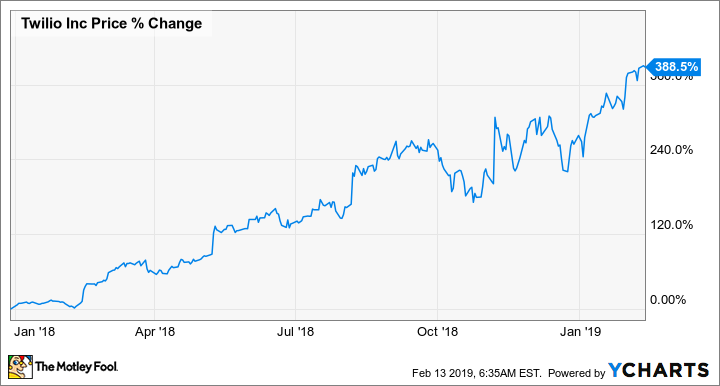After cloud communications provider Twilio (TWLO 0.59%) more than tripled in 2018, many have been left wondering whether they've missed their opportunity to invest. Despite this incredible run, investors should not despair. Thanks to its outstanding operating results, large addressable market, and focus on value-creating acquisitions, Twilio is still a buy.
Outstanding operating results
Investing in Twilio after it more than tripled during 2018 feels risky. However, winners often keep winning for many years if the underlying business results indicate long-term growth potential.
Four key metrics to evaluate Twilio's business are active customer accounts, year-over-year revenue growth, gross margin, and dollar-based net expansion rate (DBNER). DBNER represents revenue growth from active customer accounts compared to the same quarter in the previous year.
Check out the latest Twilio earnings call transcript.
Ideally, investors want to see active customers, DBNER, and revenue growth trend higher while gross margin remains stable. That's exactly what Twilio delivered last quarter, indicating that the company is gaining momentum in 2019.
| Metric |
Q4 2018 |
Q4 2017 |
Q4 2016 |
|---|---|---|---|
|
Active Customer Accounts |
64,286 |
48,979 |
36,606 |
|
Revenue Growth |
77% |
40% |
73% |
|
Gross Margin |
54% |
53% |
59% |
|
Dollar-Based Net Expansion Rate |
147% |
118% |
155% |
DATA SOURCE: TWILIO.
A leader in a growing market
Total addressable market (TAM) -- or the total revenue opportunity available for a product or service -- is one of the best indicators of a company's growth potential. Twilio is pursuing an extremely large market, the communications sector, which represented 40% of the $3.5 trillion global IT budget in 2017, according to research firm Gartner.. Management has identified smaller market opportunities within the broader communications sector for Twilio to disrupt one by one. This is similar to Amazon's disruption of retail, which began with the company selling books online in 1999.
Twilio has its sights set on the cloud-based contact center market as its first target within the broader communications sector. Contact centers are critical for customer-facing businesses because they provide a central point to manage all customer communications. Independent firm DMG Consulting, identified 2017 as "the breakthrough year when cloud-based contact center infrastructure began to dominate the market." At the end of 2016, DMG estimated cloud-based contact center infrastructure spending to be at least $2.8 billion. Considering nearly 90% of contact center seats were still on-premise at that time, revenue potential for cloud contact center spending is expected to be in the "tens of billions" as more contact centers move to the cloud.
There were 26 vendors who offered their own cloud-based contact center infrastructure, according to the same report. As of July 2017, Twilio was estimated to be in third place with 8% of all cloud-based contact center seats using Twilio's infrastructure behind only Cisco and Broadsoft, which owned 15% and 14% of seats, respectively. However, this was before Twilio released its fully programmable cloud-based contact center platform, Twilio Flex, to the general public in October of 2018. With innovative companies like Shopify and Lyft as early Flex adopters, the new platform provides a great opportunity for Twilio to become the leading cloud-based contact center provider.
Smart acquisitions
Twilio's management has an excellent track record of acquisitions. They focus on finding companies with similar cultures and best-in-class products to quickly add highly demanded enterprise capabilities. This acquisition strategy has improved Twilio's speed to market and accelerated its growth.

IMAGE SOURCE: TWILIO
At the beginning of February, Twilio completed its acquisition of cloud-based email provider Sendgrid in an all-stock deal valued at roughly $3 billion. The deal doubled Twilio's customer count to more than 140,000 active customers and enables enterprises using Twilio to reach their customers over voice, SMS messaging, Facebook Messenger, WhatsApp, video, and email. Sendgrid's CEO Sameer Dholakia summarized the acquisition in a recent press release stating that joining Twilio will "accelerate their vision of creating one unquestioned platform of choice for developers and companies around the world and help them transform the way they engage with their customers."
The SendGrid acquisition followed Twilio's acquisition of longtime partner Ytica in September, which allowed Twilio to leverage the company's "highly customizable contact center reporting, speech analytics, and workforce optimization (WFO) software" as part of Twilio Flex.
In 2015, Twilio acquired two-factor authentication company Authy because many of Twilio's customers were building authentication and verification functions independently. Twilio also benefited from adding 6,000 sites that already used Authy to its customer base. Here's how Twilio CEO Jeff Lawson summarized the acquisition in 2015, "In short, Authy had already built the solution we would have built and we found that the Authy team is exactly like Twilio in their developer focus on how they value the API approach."
Each of these acquisitions has resulted in core functionality components included in Twilio Flex. Additionally, all three deals grew Twilio's customer base, which will encourage greater adoption of Flex and future products. What is perhaps the most underappreciated aspect of Twilio's acquisition strategy is that Sendgrid's, Ytica's, and Authy's entire teams joined Twilio, giving the company decades of enterprise leadership, sales experience, and developer experience to leverage in the future.
The best is yet to come
Twilio ended 2018 firing on all cylinders, strengthening operating results, positioning itself as a leader in global IT markets, and executing smart value-creating acquisitions. Despite Twilio's incredible share performance over the last year, the company's best days are ahead of it.







